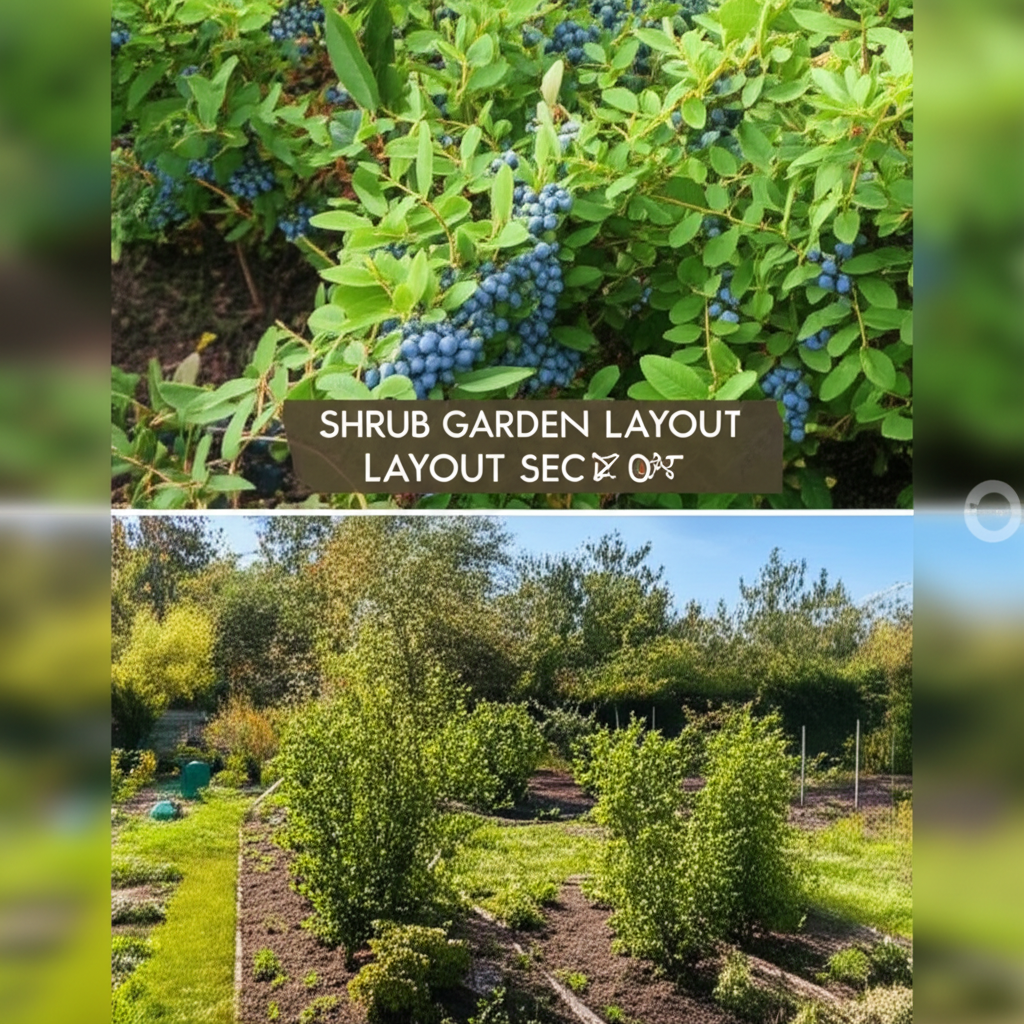Unlocking the Potential: Designing Your Honeyberry Shrub Garden
Honeyberries, also known as Haskaps, are increasingly becoming a beloved addition to home gardens. These hardy, adaptable shrubs offer a delightful trifecta of benefits: early spring blooms, attractive foliage, and most importantly, a bounty of nutritious, antioxidant-rich berries. However, to truly maximize your honeyberry harvest and enjoy a thriving, aesthetically pleasing garden, thoughtful layout and planning are paramount. This guide delves into the essential considerations for designing an effective and beautiful honeyberry shrub garden, from understanding their unique needs to creating a space that is both productive and visually appealing.
Understanding Honeyberry Needs: The Foundation of Your Layout

Before you start digging, it’s crucial to grasp the fundamental requirements of honeyberry shrubs. Their specific needs will dictate spacing, companion planting, and overall garden design.
Pollination Partners: The Key to Fruit Production
One of the most critical aspects of honeyberry cultivation is pollination. Honeyberry plants are not self-fertile, meaning you need at least two different varieties for cross-pollination and a successful fruit set. Planting just one variety will result in beautiful blossoms, but very few, if any, berries.
- Variety Selection: Research and choose varieties known to cross-pollinate well. Some popular and reliable pairings include ‘Borealis’ with ‘Tundra’, or ‘Aurora’ with ‘Honey Bee’.
- Proximity: For effective pollination, the different varieties need to be planted close enough for pollinators to easily transfer pollen between them.
Sunlight Requirements: Embracing the Rays
Honeyberries thrive in full sun, meaning they require at least 6-8 hours of direct sunlight per day. Adequate sunlight is essential for robust growth, abundant flowering, and sweet, flavorful berries.
- Site Selection: Choose a location in your garden that receives consistent, unobstructed sunlight throughout the day.
- Avoiding Shade: Be mindful of taller trees, buildings, or other large plants that could cast shade on your honeyberry bushes, especially during the peak growing season.
Soil and Drainage: The Lifeblood of Your Bushes
While honeyberries are remarkably tolerant of various soil types, they perform best in well-drained, slightly acidic to neutral soil (pH 5.5-7.0). Poor drainage can lead to root rot, a common problem that can significantly hinder or even kill the plants.
- Soil Amendment: If your soil is heavy clay, incorporate organic matter such as compost, well-rotted manure, or peat moss to improve drainage and aeration.
- Raised Beds: For areas with persistently waterlogged soil, consider planting honeyberries in raised beds to ensure adequate drainage.
Watering Needs: Consistent Moisture is Key
Newly planted honeyberries require consistent moisture to establish a strong root system. Once established, they are relatively drought-tolerant, but regular watering during dry spells will promote healthier growth and better fruit production.
- Mulching: Apply a layer of organic mulch around the base of the plants to help retain soil moisture, suppress weeds, and regulate soil temperature.
Key Facts and Comparison: Honeyberry Varieties for Layout Planning
When designing your honeyberry garden, selecting the right varieties is crucial not only for pollination but also for staggered harvesting and potential differences in growth habits. Here’s a look at some popular varieties and their characteristics to aid your planning.
| Variety | Origin | Berry Size | Flavor Profile | Hardiness Zone | Typical Ripening Time | Growth Habit |
|---|---|---|---|---|---|---|
| Borealis | Saskatoon, Canada | Medium-Large | Sweet-tart, mild flavor | 3-7 | Early June | Upright, spreading |
| Tundra | Saskatoon, Canada | Medium | Sweet, less tart than Borealis | 2-7 | Early-Mid June | Upright, compact |
| Aurora | Saskatoon, Canada | Large | Sweet, complex flavor with hints of blueberry and cherry | 2-7 | Mid-June | Upright, spreading |
| Honey Bee | Saskatoon, Canada | Medium | Sweet, slightly tart | 3-7 | Mid-June | Upright, dense |
| Indigo Treat | Saskatoon, Canada | Large | Sweet, juicy, blueberry-like | 3-8 | Mid-June | Upright, vigorous |
Garden Layout Strategies: Maximizing Space and Productivity
With a solid understanding of honeyberry needs, let’s explore effective layout strategies to create a functional and beautiful garden.
Spacing Considerations: Allowing Room to Grow
Proper spacing is essential to prevent overcrowding, ensure adequate air circulation, and allow for easy harvesting and maintenance.
- Plant-to-Plant Spacing: Aim for 4-6 feet between individual honeyberry plants within the same variety. This allows them to reach their mature size without competing for resources.
- Row Spacing: If planting in rows, maintain 6-8 feet between rows. This provides ample space for walking, weeding, and accessing the plants with tools or a wheelbarrow.
- Pollinator Proximity: As mentioned, plant your different honeyberry varieties within 10-20 feet of each other to facilitate cross-pollination.
Layout Designs: From Formal Rows to Naturalistic Groupings
Your layout can be as simple or as elaborate as your garden vision allows.
- Linear Rows: A classic and efficient layout, particularly if you have ample space. This makes harvesting and maintenance straightforward.
- Polyculture or Mixed Borders: Integrate honeyberry bushes into existing perennial borders or vegetable gardens. This creates a more naturalistic and visually diverse planting. Ensure they are placed where they receive sufficient sunlight and are not overshadowed.
- Hedges or Screens: Plant honeyberries in a line to create a natural screen or hedge. This is an excellent way to define garden spaces or provide a backdrop for other plantings.
- Groupings or Islands: Plant 3-5 honeyberry plants of different varieties together in a naturalistic grouping or “island.” This can be a visually striking feature and ensures good pollination.
Companion Planting: Enhancing Your Honeyberry Patch
Companion planting involves strategically placing different plants together to benefit one another. While honeyberries are generally robust, certain companions can further enhance their growth and deter pests.
- Beneficial Insect Attractors: Plants like lavender, bee balm, and coneflowers attract pollinators, which are crucial for honeyberry fruit set. They also attract beneficial insects that prey on common garden pests.
- Ground Cover: Low-growing herbs like thyme or oregano can act as a living mulch, suppressing weeds and retaining moisture around the base of the honeyberry bushes.
- Avoid Problematic Companions: While honeyberries are adaptable, it’s generally best to avoid planting them too close to aggressive self-seeders or plants known to attract specific pests that might also target honeyberries. However, honeyberries are generally quite pest-resistant, so this is less of a concern than with some other fruit-bearing plants.
Optimizing Your Honeyberry Garden Layout: Practical Tips
Beyond the basic design principles, several practical tips can ensure your honeyberry garden thrives and delivers maximum yield.
Accessibility and Maintenance: Ease of Care
A well-planned layout makes gardening a pleasure, not a chore.
- Pathways: Incorporate clear pathways between rows or around groupings to facilitate easy access for watering, weeding, fertilizing, and harvesting.
- Weed Control: Design your layout with weed management in mind. Companion planting with ground covers or using mulch can significantly reduce the need for manual weeding.
Harvesting Efficiency: Reaching Every Berry
The goal is a bountiful harvest, and your layout can help achieve this.
- Height and Spread: Consider the mature height and spread of the varieties you choose. This will influence how closely you plant them and how easily you can reach the berries.
- Pruning Access: Ensure you have enough space around each bush to comfortably prune them annually, which is essential for maintaining plant health and fruit production.
Aesthetic Appeal: Beauty and Bounty
Your honeyberry garden can be a visual delight as well as a source of delicious fruit.
- Foliage and Bloom: Honeyberry plants offer attractive foliage in shades of green, often with a slightly silvery underside. Their delicate white or pinkish flowers in early spring are a welcome sight.
- Year-Round Interest: Consider incorporating plants with complementary textures and colors that provide interest throughout the seasons, even when the honeyberries are dormant.
- Edible Landscaping: Integrate your honeyberry bushes into an edible landscape, where functional plants also contribute to the garden’s beauty.
Implementing Your Honeyberry Garden Layout: Step-by-Step
Here’s a breakdown of the steps involved in bringing your honeyberry garden layout to life.
| Step | Description | Key Considerations |
|---|---|---|
| 1. Site Assessment | Evaluate your garden for sunlight, soil type, drainage, and existing structures. | Full sun is crucial. Check for waterlogged areas. |
| 2. Variety Selection | Choose at least two compatible honeyberry varieties for cross-pollination. | Consider ripening times and flavor profiles. |
| 3. Layout Planning | Sketch your garden layout, marking plant positions, pathways, and any companion plantings. | Ensure adequate spacing and proximity for pollinators. |
| 4. Soil Preparation | Amend the soil with organic matter to improve drainage and fertility. | Test soil pH if possible. |
| 5. Planting | Dig holes twice the width of the root ball and plant at the same depth as they were in their nursery container. | Water thoroughly after planting. |
| 6. Mulching | Apply a 2-3 inch layer of organic mulch around the base of the plants. | Keep mulch a few inches away from the trunk to prevent rot. |
| 7. Watering and Care | Water consistently, especially during the first year, and monitor for any signs of stress or pests. | Observe your plants and adjust care as needed. |
Pros and Cons of Different Layout Approaches
Every garden design has its advantages and disadvantages. Understanding these can help you make the best choices for your specific situation.
| Layout Approach | Pros | Cons |
|---|---|---|
| Linear Rows | Efficient for large-scale planting, easy harvesting and maintenance, clear organization. | Can be less aesthetically pleasing in smaller gardens, may require more defined pathways. |
| Groupings/Islands | Visually appealing, excellent for cross-pollination, creates a naturalistic look. | Can be slightly more challenging to manage weeds within the grouping, requires careful spacing to avoid overcrowding. |
| Mixed Borders/Polyculture | Enhances biodiversity, improves soil health through companion planting, aesthetically pleasing. | Requires careful selection of companions to avoid competition, may make harvesting slightly more involved if plants are densely packed. |
| Hedges/Screens | Defines garden spaces, provides a natural barrier, offers a continuous harvest. | Requires consistent pruning to maintain shape and health, may limit access to individual plants if too dense. |
Troubleshooting Common Layout Challenges
Even with the best planning, you might encounter a few hurdles. Here’s how to address them.
- Overcrowding: If your plants are growing into each other, consider carefully pruning them back to manage their size. In extreme cases, you might need to transplant one of the bushes to a new location.
- Poor Fruit Set: This is almost always a pollination issue. Ensure you have at least two different varieties planted close enough. Check if pollinators are active in your garden; consider planting more pollinator-attracting flowers nearby.
- Waterlogging: If you notice plants struggling due to excessive moisture, especially after heavy rains, consider improving drainage by adding organic matter or creating small berms around the base of the plants.
- Weed Competition: If weeds are overwhelming your young honeyberry bushes, apply a thicker layer of mulch or consider planting a dense ground cover around them.
Conclusion: Crafting Your Bountiful Honeyberry Haven
Designing your honeyberry shrub garden layout is an investment in future harvests and garden enjoyment. By understanding the specific needs of these remarkable plants – particularly their requirement for cross-pollination – and by carefully considering spacing, sunlight, and companion planting, you can create a garden that is not only highly productive but also a beautiful and harmonious addition to your landscape. Whether you opt for neat rows or a more naturalistic arrangement, a well-thought-out layout will ensure your honeyberry bushes thrive, offering you a consistent supply of delicious, health-boosting berries for years to come. Happy planting!


